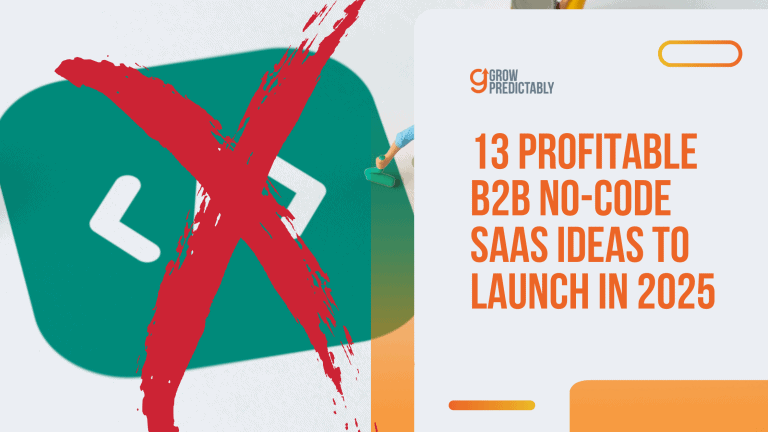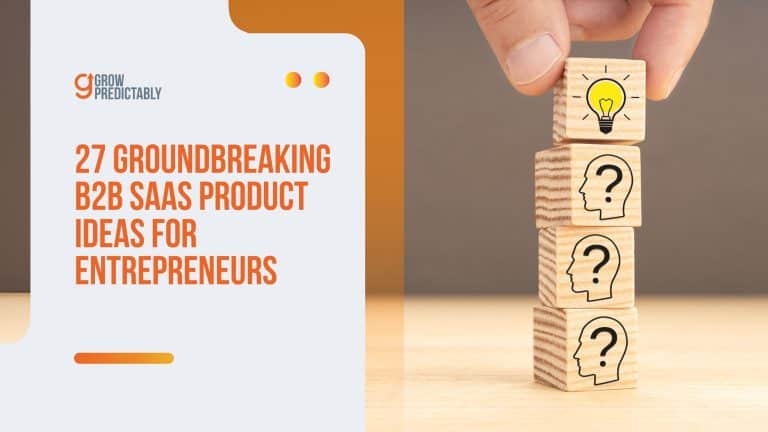5 Ways to Create B2B SaaS Thought Leadership Content + 3 Examples to Learn From
You know the struggle of trying to establish your SaaS brand as a thought leader, right? It’s not easy, especially when you’re competing against countless others in the B2B space.
Checking in on your B2B SaaS thought leadership content pays! One common mistake is believing that just having a lot of content will make you a thought leader.
But the reality is quantity without quality won’t get you far. It’s all about aligning your content with the right goals and audience pain points.
By overcoming this myth and focusing on building strategic, data-driven content, you’ll see your authority grow and your audience engage at a much deeper level.
Ready to transform your content strategy?
Let’s explore how to use these insights to create thought leadership content that stands out.
TL;DR
To build thought leadership that actually connects and drives results, start by mapping precise buyer personas, solve their core problems with data-backed insights, and tell customer-centered stories. Distribute consistently, invite feedback, and measure impact. These steps align authority, relevance, and conversion across your B2B SaaS marketing funnel for measurable growth.
KEY TAKEAWAYS
- Map 3–5 buyer personas, identify their top pain points, and prioritize three content topics per buying stage.
- Produce one data-backed pillar piece monthly and repurpose it into short posts, infographics, and a case study for broader reach.
- Add CTAs, polls, and tracking on each asset; review engagement-to-lead metrics monthly and iterate based on results.
What Is Thought Leadership in B2B SaaS?
Thought leadership is all about positioning a brand or individual as an authority in their field. It means sharing unique insights and innovative ideas that can influence others.
In the B2B SaaS world, this is key. It involves sharing expertise on industry trends, tackling challenges, and offering solutions.
This is often done through content like blogs, webinars, and whitepapers. Thought leadership content plays a big role in building credibility and trust with an audience.
By consistently sharing high-quality insights, companies can establish themselves as leaders in their industry. This content not only educates and engages but also helps create a loyal community that looks to the brand for guidance.
Once the audience begins looking up to you for guidance, this means your ideas are helping shape you as an industry leader.
Shel Israel, author of the books “Twitterville: How Businesses Can Thrive in the New Global Neighborhoods” and “Age of Context: Mobile, Sensors, Data and the Future of Privacy” gave his dissection on what makes a thought leader in one of his Forbes pieces.
In this Forbes article, Shel Israel quotes:
A thought leader is someone who looks at the future and sets a course for it that others will follow.
Shel Israel
Having established the importance and defining characteristics of thought leadership in the B2B SaaS arena, it’s crucial to explore how leveraging this approach can offer tangible benefits to your B2B.
By integrating thought leadership into your content marketing strategy, you can unlock several key advantages that enhance your company’s competitive edge.
What Are The Benefits of Thought Leadership in B2B SaaS?
Investing in thought leadership content can transform B2B SaaS businesses in several key ways.
To maximize these benefits, it’s essential to integrate thought leadership into a comprehensive marketing strategy.
Here are the top benefits:
1. Enhanced Brand Authority
Thought leadership positions your company as an expert in the industry.
In a The New York Times trend, 65% of buyers say that a thought leadership piece changed their perception of a company for the better. (Source)
By consistently sharing valuable insights and forward-thinking concepts, your brand becomes a go-to resource for information and innovation.
This authority not only attracts potential clients but also builds trust among your existing customer base.
As your company becomes synonymous with expertise, it paves the way for long-term success and recognition in the competitive SaaS market.
2. Increased Credibility
Creating thought leadership content demonstrates your commitment to industry leadership and innovation.
When your brand regularly contributes to important conversations and provides insightful analysis, it solidifies its reputation as credible and reliable.
Based on a LinkedIn research, 60% of buyers say thought leadership builds credibility when entering a new category where the brand is not already known. (Source)
This credibility can lead to stronger relationships with partners, investors, and customers who are more likely to engage with a brand they trust.
3. Stronger Customer Engagement
Thought leadership content encourages active engagement with your audience. By addressing common challenges and offering solutions, you foster deeper connections with your customers.
This engagement can lead to increased customer loyalty as clients feel understood and valued.
Did you know, according to a The New York Times trend, 48% of thought leadership content generates actual leads and sales? (Source)
Regular interaction through thought-provoking content helps maintain interest and cultivates a community around your brand.
Now that we understand the key benefits thought leadership can bring to B2B SaaS companies, it’s time to explore the diverse types of content that can help you achieve these advantages.
By employing various content strategies, you can craft impactful messages that resonate with your audience and reinforce your brand’s authority.
What Are Different Types of Thought Leadership Content for B2B SaaS?

Thought leaders can leverage various approaches to create impactful content.
If you scan the web, you’ll see different thought leaders utilizing different styles in creating thought pieces, including the posts and visuals they produce on social media platforms.
But, if you really want to boost the impact of your thought pieces, it pays to learn these strategies below:
1. Personal Experience
Sharing personal stories and experiences can create a unique connection with your audience. When thought leaders draw from their own journeys, it adds authenticity and relatability to their content.
This approach is effective because it humanizes thought leaders, making their insights more accessible and engaging to a broader audience.
However, it’s crucial to focus on stories that are relevant and valuable to the audience. Thought leaders should avoid exaggeration or embellishing stories with details that don’t contribute to the message. This can quickly erode trust if discovered.
2. Data-Driven Insights
Incorporating data and statistics can significantly enhance the credibility of thought leadership content. Using well-researched and up-to-date data helps back up claims and provides a solid foundation for arguments.
Thought leaders should focus on presenting data in a way that’s easy to understand and directly supports their key points.
It’s important to avoid cherry-picking data that only supports one side of the argument or ignoring contradictory data, as this can lead to biased conclusions and harm your credibility.
3. Contradicting Opinions
Taking a stance that challenges conventional wisdom can provoke thought and engage audiences in meaningful discussions. Thought leaders who aren’t afraid to present contradicting opinions can stand out as innovative and bold.
When using this approach in thought leadership, it’s important to foster an open and respectful discourse. Clearly articulate why the opposing view holds merit and provide evidence or reasoning.
However, leaders should avoid being contrarian solely for the sake of being different, as this can come off as disingenuous or superficial.
By effectively using these approaches, thought leaders can produce content that not only informs but also inspires and engages their audience.
After delving into the different types of thought leadership content and their potential impact, the next step is to understand how to strategically craft such content for maximum engagement and conversion.
By following a structured approach, you can turn these insights into tangible results for your B2B SaaS marketing efforts.
How Do You Craft B2B SaaS Thought Leadership Content That Connects?

Creating thought leadership content in the B2B SaaS space requires strategy and clarity; it’s not just all about memes and being flashy.
Have you experienced getting easily carried away when creating content before? We did… To avoid that, you need a thought leadership content strategy.
Here are five key points to help you craft content that not only engages but also converts.
1. Understand Your Audience First
Knowing who you’re speaking to is crucial. It allows you to tailor your message to meet the specific needs and interests of your target audience.
According to a resource from Harvard Business School, “Identifying your target audience not only informs current marketing initiatives but helps you adapt to changes your customers may experience.” (Source)
When your audience finds content relevant, they’re more likely to engage and act.
Step-by-Step Guide:
- Identify Key Personas: Define the typical roles and responsibilities of your target audience.
- Conduct Surveys and Interviews: Gather insights on their pain points and interests.
- Analyze Competitor Content: See what’s resonating with their audience and identify gaps you can fill.
- Create Detailed Profiles: Use your findings to craft detailed audience personas.
Using a customer avatar canvas proved pivotal in creating B2B SaaS thought leadership content for my social handles. In one instance, the canvas revealed that my initial content didn’t resonate with my target audience, highlighting areas of disconnect.
This insight allowed me to redirect and prioritize more relevant topics, ensuring my messaging aligned with the audience’s needs and interests. As a result, I was able to prioritize content on topics that were more relevant to the pain points of my target audience, fostering stronger connections with my audience.
2. Focus on Solving Problems
Regardless of industry trends, your content should address the real challenges your audience faces. By offering solutions, you establish your brand as a trusted advisor, which can lead to more conversions and, eventually, business growth.
Step-by-Step Guide:
- List Common Industry Challenges: Use insights from your audience research.
- Match Challenges to Your Solutions: Identify how your SaaS product addresses these issues.
- Develop Content Around Solutions: Create guides, case studies, or articles that show how your product solves specific problems.
- Measure Impact: Gather feedback to refine your message and ensure it’s hitting the mark.
3. Leverage Data and Insights
Using reliable data enhances credibility and provides concrete evidence to support your claims. Valuable insights in bite-sized content build trust, making your audience more likely to engage and convert because of the industry knowledge you offer.
Step-by-Step Guide:
- Collect Industry Data: Gather statistics and research relevant to your field.
- Use Visuals: Present data in charts or infographics to make it digestible.
- Integrate Data into Narratives: Use data to back up your points, making sure it’s relevant and supports your argument.
- Regular Updates: Keep your data current to maintain credibility.
4. Engage Through Storytelling
People connect with stories. By weaving storytelling into your thought leadership strategy, you can make complex topics relatable and memorable, encouraging readers to take action.
Take a moment and ponder on these questions…
What career experience has helped shaped my approach today, or what recent experience has prompted me to do a ‘double take’ that others might learn a thing or two from?
Step-by-Step Guide:
- Identify a Core Message: What do you want your audience to learn or feel?
- Use Real-Life Examples: Share customer success stories or personal experiences.
- Craft a Compelling Narrative: Structure your content with a clear beginning, middle, and end.
- Incorporate Emotional Triggers: Make your audience feel connected to the story.
In one of my posts, I shared a personal experience that really clicked with readers. By diving into my own journey, I showed them how the topic I was discussing plays out in the real world.
It wasn’t just theory—it was something they’d see in action.
This approach helped readers realize they could achieve similar results, making the whole concept more relatable and actionable in their minds. Sharing stories can really bridge that gap, especially when readers can relate to and see themselves in your stories.
5. Encourage Interaction and Feedback
Interactive content encourages engagement, while feedback helps you refine your approach and understand your audience better.
Based from the research Effects of Interactivity in a Web Site: The Moderating Effect of Need for Cognition, interactive elements in a website leads to higher favorability toward the product or offer. (Source)
Step-by-Step Guide:
- Include CTAs (Call to Actions): Prompt readers to share their thoughts or ask questions.
- Utilize Interactive Elements: Polls, quizzes, or forums can boost engagement.
- Set Up Feedback Loops: Use surveys or comment sections to gather insights.
- Respond Promptly: Show your audience that their opinions are valued by engaging with their feedback.
By focusing on these key points, B2B SaaS marketers can create thought leadership content that not only captures attention but also drives conversions.
You might want to do a quick review of your recently published pieces of content. Is it starting to seem a little too plain? Maybe you can use a quick poll or highlight a survey that can stir a discussion.
Each of these steps is designed to be straightforward, ensuring that any marketer can implement these strategies with ease. With your content strategy now laid out, let’s make sure your efforts align with some proven best practices that enhance your B2B SaaS thought leadership.
Simple yet effective adjustments can turn your content into a powerful tool for engaging and inspiring your audience.
What Are Best Practices for Writing B2B SaaS Thought Leadership Content?

Navigating thought leadership in B2B SaaS should not be without a system. But creating thought leadership content doesn’t always have to be rocket science either.
Even just observing a few best practices when creating content for thought leadership can already go a very long way. When creating thought leadership content, remember to:
- Write from an expert’s POV
- Be consistent across different channels
- Encourage dialogue with your audience
How can you do that? Here are a few quick tips to take note of:
1. Writing from an Expert POV
- Authenticity is Key: Share personal insights to build trust.
- Boost Authority: Reference industry studies and expert opinions.
- Diverse Perspectives: Enrich your content by including various expert viewpoints.
2. Consistency and Multi-Channel Promotion
- Align Across Platforms: Keep your message and tone consistent everywhere.
- Fulfill Search Intent: Deliver what your audience seeks across blogs, videos, and infographics.
- Broaden Reach: Use multi-channel strategies like repurposing content for different mediums.
3. Encourage Engagement and Dialogue with Your Audience
- Invite Dialogue: Create content that prompts questions and discussions.
- High-Value Curiosity: Keep readers intrigued by focusing on their interests.
- Foster Community: Use polls and feedback to build interaction and refine content.
Implement these practices to enhance your B2B SaaS thought leadership, ensuring your content informs, inspires, and engages.
Now that we’ve covered the best practices for crafting standout thought leadership content let’s dive into some real-world success stories. Check out how top industry leaders are putting these principles into action to inspire your own creative strategies.
Are There Real-World Examples of Successful Thought Leadership Content in B2B SaaS?
We’ve shown you the different types of approaches you can take and the steps to observe in order to produce your content for B2B SaaS thought leadership.
If you think you’re ready to get creative with your next thought leadership piece, take inspiration from these examples of famous thought leaders in the SaaS industry to supercharge results:
1. Jason M. Lemkin on Marketing Strategies
Jason M. Lemkin shares his insights on effective marketing strategies in a LinkedIn post. He emphasizes the importance of building a quality list of engaged audience members rather than focusing solely on quantity.
Lemkin’s approach involves curating valuable content and sharing insights from both his experience and other respected sources.
Readers can learn how prioritizing engagement over sheer numbers can enhance marketing effectiveness and foster a robust community around their brand.

Lemkin focuses on building a quality list of engaged audience members, aligning with the principle of understanding the audience’s needs and interests, which is number one in our guide to creating effective thought leadership content earlier.
2. Dharmesh Shah on Co-Founding Success
In an interview with Sequoia Capital, Dharmesh Shah, co-founder of HubSpot, discusses the significance of having a complementary co-founder. He shares personal anecdotes and advice on maintaining balance and making critical business decisions.
Shah’s candid reflections provide valuable lessons on collaboration, risk management, and the impact of company culture. This content offers readers insights into successful co-founder relationships and operational strategies.

Shah effectively uses storytelling by sharing personal anecdotes, which resonates with the principle of making content relatable through real-life examples. His reflections also offer actionable solutions for maintaining balance and making critical business decisions in co-founder relationships, which addresses audience challenges.
In your next post, ask yourself this: “What’s one challenge my SaaS customers face that I can address in my next thought leadership piece?”
3. Neil Patel on Unconventional Marketing
Neil Patel, a renowned marketing expert, discusses unconventional marketing strategies in a podcast with DesignRush. He highlights the benefits of thinking outside the box, such as giving away products for free to build brand loyalty.
Patel’s approach challenges traditional marketing norms and encourages businesses to innovate and adapt to changing market dynamics. Readers can take away ideas on leveraging unconventional strategies to achieve surprising business success.

By discussing innovative strategies, Patel invites dialogue and encourages businesses to think creatively, fostering a community of learning and feedback.
How to Measure the Impact of Your B2B SaaS Thought Leadership Content
Creating high-quality B2B SaaS thought leadership content is crucial, but equally important is measuring its success. Tracking the right metrics helps you gauge your content marketing, audience resonance, and business impact.
Here are the three most important metrics to gauge the effectiveness of your B2B SaaS thought leadership content:
1. Audience Engagement (Time on Page, Comments, Shares)
Engagement shows how deeply your audience interacts with your content. If your content is engaging, it indicates that it’s relevant and valuable to your target audience.
By looking at metrics such as time on page, comments, and social shares, you can gauge how well your content connects with your audience.
- Google Analytics: Track time on page, bounce rates, and session duration.
- BuzzSumo: Monitor social shares and overall engagement.
- Comments: Track the number of comments or interactions on your blog and social media posts.
2. Lead Generation (Form Submissions, Downloads, Sign-ups)
Thought leadership content should not only inform and engage but also help generate qualified leads for your SaaS business. Lead generation shows how well your content is driving action and contributing to your sales funnel.
You can determine how persuasive and actionable your content is by tracking how many readers convert into leads after interacting with your thought leadership content.
- Google Analytics Goals: Set up goals to track form submissions, downloads, and sign-ups.
- HubSpot or Marketo: Monitor lead generation through CRM and marketing platforms.
- UTM Parameters: Use specific URLs to track where leads are coming from.
3. Backlinks and Domain Authority
Backlinks and domain authority are essential indicators of your content’s credibility and authority in the SaaS industry. When other reputable websites link to your content, it signals to search engines and audiences that your thought leadership is trusted and valuable.
If your thought leadership content is generating backlinks from authoritative sites, it demonstrates that your ideas are recognized and respected in the industry.
- Ahrefs, Moz, or SEMrush: Track backlinks, domain authority, and which content is earning the most links.
- Google Search Console: Monitor which sites are linking to your content.
⮞ What are common thought leadership mistakes?
Quick overview: the biggest failures are avoidable and usually come from strategy gaps rather than creativity shortfalls.
Below are the most common mistakes and how they hurt B2B SaaS thought leadership:
• Being promotional instead of helpful. Thought leadership that reads like a sales pitch loses credibility fast. Readers want insights, not product demos.
• Missing a unique point of view. Rehashing common ideas won’t build authority. Original angles or proprietary frameworks matter.
• Ignoring the audience. Content that doesn’t map to buyer roles, pain points, or buying stages gets ignored.
• Inconsistent publishing. Sporadic output fails to build momentum or trust over time.
• Overcomplicated language. Jargon and vague claims make ideas hard to act on. Clarity wins.
• No evidence or examples. Claims without data, case studies, or customer stories feel flimsy.
• Poor distribution planning. Great content that no one sees is wasted. Channel strategy and SEO are essential.
• Not measuring business impact. If you don’t track engagement, leads, or influence, you can’t optimize or justify investment.
Fix these and your thought leadership will start to perform as a demand-generation and brand-building asset.
⮞ What are the pillars of thought leadership?
Thought leadership stands on a few simple, connected pillars.
• First, authority: the content must show deep domain expertise and real experience.
• Second, originality: offer perspectives, frameworks, or data people can’t get elsewhere.
• Third, relevance: address the current challenges and decisions your audience faces now.
• Fourth, credibility: back claims with evidence—case studies, data, third-party validation.
• Fifth, consistency: publish consistently so your voice becomes a trusted signal in the market.
• Sixth, accessibility: present ideas in formats and language that busy practitioners can consume and act on.
• Seventh, usefulness: every piece should have clear takeaways or next steps for readers.
• Eighth, distribution: even excellent content needs a strategic plan to reach buyers, influencers, and partners.
These pillars work together. Authority without relevance is noise. Originality without credibility is risky. Consistency without usefulness wastes budget.
When you balance all pillars, thought leadership moves from “nice to read” to a business-driving asset that accelerates trust, shortens buying cycles, and supports premium positioning.
⮞ What are the 4 types of thinking leaders need to practice?
Brief overview: to craft meaningful thought leadership and steer an organization, leaders should practice four complementary thinking modes.
Each strengthens content and strategy in different ways.
1. Strategic thinking. Focuses on long-term positioning, market trends, and how content maps to business goals. Use it to prioritize topics that open new accounts or protect renewal rates.
2. Systems thinking. Sees how content, product, sales, and customer success interact. It prevents siloed campaigns and ensures content supports the buyer journey end-to-end.
3. Critical thinking. Questions assumptions and tests ideas against data. This prevents publishing clichés and helps you refine hypotheses into defensible insights.
4. Creative (or divergent) thinking. Generates fresh angles, metaphors, and formats that cut through noise. It’s where unique frameworks and memorable narratives originate.
Rotate between these modes when planning and producing thought leadership. Strategic and systems thinking set the direction.
Critical thinking validates rigour. Creative thinking generates the standout ideas that attract attention and build influence.
⮞ What makes a good thought leadership piece?
A good thought leadership piece starts with a clear, defensible point of view. It presents an original idea or a new synthesis of existing trends.
The argument is supported by evidence—data, examples, customer stories, or experiments. It speaks directly to a defined audience and maps to a specific business or buyer question.
The writing is concise and structured so readers can scan and still walk away with clear takeaways. Strong pieces include actionable guidance: frameworks, checklists, or recommended next steps that readers can apply immediately.
Good thought leadership also anticipates counterarguments and addresses limitations honestly. It uses storytelling to make abstract ideas tangible, but it avoids empty narratives that lack substance.
Finally, distribution matters: a great piece paired with a channel plan, repurposing, and measurement turns influence into pipeline. When these elements align, content builds trust, shapes market perception, and supports measurable business outcomes.
Key Takeaways
Thought leadership content is vital for establishing your B2B SaaS brand as an industry leader.
By creating high-quality thought leadership content that shares valuable insights, solves real problems, and engages your audience through storytelling, you build trust, authority, and lasting connections with your customers.
From understanding your audience to leveraging data and sharing personal experiences, this blog has outlined the key strategies for producing content that not only informs but also inspires action.
These steps will help you elevate your thought leadership and, ultimately, drive business growth.
Now is the time to implement these strategies and start creating B2B SaaS thought leadership content that resonates with your audience and positions you as a trusted voice in your industry.
For more tips and insights, be sure to check out our other blogs on digital marketing, business strategies, and mindset or book a call to continue your journey toward growth and success!








